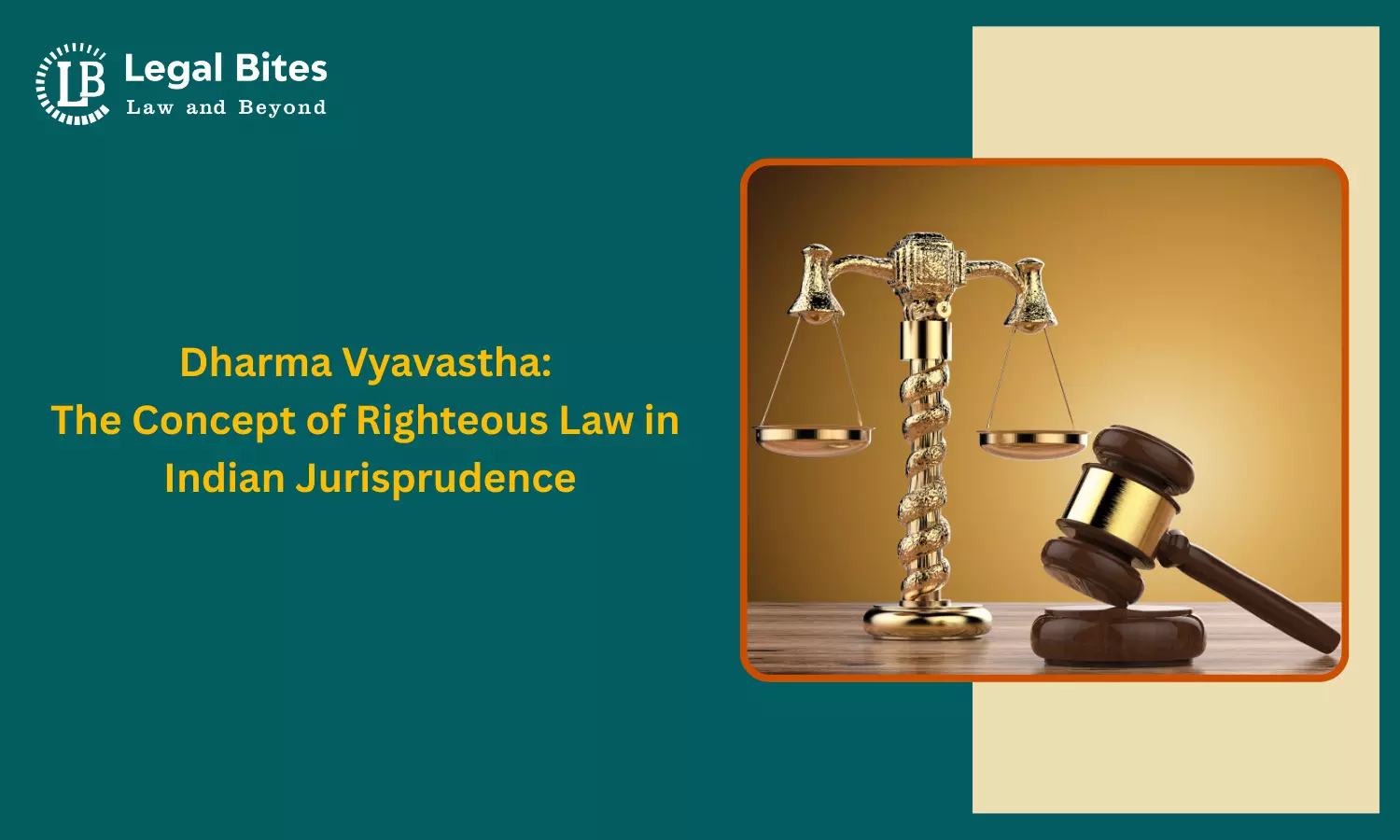Dharma Vyavastha: The Concept of Righteous Law in Indian Jurisprudence
This article explores how Dharma's ethical and duty-based ideals still shape Indian jurisprudence and inform contemporary concepts of justice.

The term Dharma Vyavastha—translated as “righteous law” or the “system of justice based on dharma”—occupies a pivotal place in Indian jurisprudence. It bridges ancient Indian legal-philosophical traditions with contemporary understandings of law and justice. Unlike Western legal thought, which predominantly emphasises the sovereign’s will and codified statutes, the Indian concept of law finds its roots in dharma, an idea that transcends mere legal rules to encompass ethical conduct, cosmic order, duty, and righteousness.
This article explores the philosophical foundations, evolution, and practical relevance of Dharma Vyavastha and assesses its contemporary resonance in Indian constitutional thought.
Understanding Dharma: Beyond Religion
1. Meaning and Etymology
The word dharma is derived from the Sanskrit root "dhṛ" meaning "to hold" or "to support." Thus, dharma implies that which upholds the universe, society, and the individual. It includes legal norms (vyavahara), moral obligations, duties, and even spiritual ideals.
Dharma is not merely a religious or scriptural idea—it is a universal principle of righteous living, which varies according to one's role in society, age, context, and capacity.
2. Scope of Dharma in Legal Thought
In ancient Indian jurisprudence, law (nyaya or vyavahara) was considered a subset of dharma, and not an autonomous field. Thus, the concept of Dharma Vyavastha reflects a holistic system of justice that integrates morality, ethics, duty, and legal procedures.
Sources of Dharma Vyavastha
Ancient Indian legal philosophy outlined the sources of dharma and its codification in legal systems. The principal sources are:
1. Shruti (Vedas)
The Vedas are the foundational scriptures of Hindu thought. Although not legal codes, they set out the philosophical underpinnings of righteous behavior, cosmic order, and individual duty.
2. Smriti (e.g., Manusmriti, Yajnavalkya Smriti)
These texts interpret the Vedas and translate them into social rules and legal codes, often addressing civil and criminal matters.
3. Custom (Aachara)
Customs and social practices that are not contradictory to moral values were considered a legitimate source of dharma.
4. Judicial Precedent and Reasoning (Nyaya)
Rulings of learned jurists (vyavahara), yuktis (reasoning), and sadachara (good conduct of virtuous men) played a role in shaping dharma for particular cases.
Core Elements of Dharma Vyavastha
1. Duty over Rights
In Western legal thought, the individual is the focal point, and the concept of rights dominates. Dharma Vyavastha is duty-centric. It focuses on one's obligations towards others—parents, society, nature, and even strangers.
“One’s duty is one’s right”—an idea deeply embedded in Gita and other Dharmic texts.
2. Contextual Justice (Swadharma)
Justice is not uniform or one-size-fits-all. Dharma varies based on:
- Varna (role in society),
- Ashrama (stage of life),
- Desha-Kala (place and time),
- Guna-Karma (qualities and actions).
This reflects a flexible and contextual idea of justice, distinct from rigid legal formalism.
3. Restorative and Harmonious Justice
Dharma aims not at retribution but at the restoration of order and harmony. Punishment (if any) is not merely penal but transformative
Dharma Vyavastha in Ancient Legal Texts
1. Manusmriti
The Manusmriti, one of the most discussed texts, lays out rules for civil and criminal matters, governance, duties of kings, and social obligations. While often criticised for endorsing hierarchical structures, it presents a view of law as inseparable from morality.
“Dharma is eternal and immutable; it is the highest standard of justice.” – Manu
2. Arthashastra
Kautilya’s Arthashastra represents a more pragmatic version of Dharma Vyavastha, recognising statecraft, public welfare, and political realism while still upholding dharma as a guiding ideal.
Dharma and Nyaya: The Twin Pillars
Amartya Sen distinguishes between Niti (institutional justice) and Nyaya (realized justice). Dharma Vyavastha aligns with Nyaya—concerned with actual lived justice, not just rules and institutions.
The Mahabharata frequently explores this theme, often showing dilemmas where following rigid rules leads to injustice, while flexible application of dharma restores fairness.
Dharma Vyavastha and Indian Constitutional Law
Even though modern Indian law is based on the common law tradition, elements of Dharma Vyavastha persist:
1. Directive Principles of State Policy (DPSPs)
These reflect ethical and moral goals of governance, mirroring dharma. For example:
Article 39: Welfare of the people
Article 48A: Environmental protection
Article 51: Promotion of international peace
2. Public Interest Litigation (PIL)
The Supreme Court’s epistolary jurisdiction and social action litigation embody nyaya—bringing real justice to marginalised communities, even if not strictly legal in origin.
3. Environmental Jurisprudence
Indian courts have invoked ancient notions of ecological dharma to justify legal interventions. E.g., the recognition of rivers as legal persons (Ganga, Yamuna).
Criticism and Limitations
While the ideals of Dharma Vyavastha are noble, certain criticisms must be acknowledged:
- Justification of Hierarchy: Some interpretations of dharma, especially those in Smritis, reinforce caste hierarchies and gender bias. This is incompatible with modern equality.
- Vagueness and Subjectivity: The flexibility of dharma can lead to arbitrariness. Without a fixed legal code, interpretation depends heavily on the judge’s morality or the king’s discretion.
- Incompatibility with Constitutionalism: Modern democratic societies demand clarity, codification, and rights-based protection. Dharma’s duty-based ethics may sometimes conflict with this model.
Revival and Contemporary Relevance
Despite criticisms, the moral core of Dharma Vyavastha offers meaningful insights for contemporary law:
1. Duty-based Ethics in Governance
During crises like COVID-19, focus on duty—towards community, elders, environment—proved vital. Dharma offers a communitarian vision.
2. Restorative Justice Models
Indian village panchayats and nyaya panchayats often work on reconciliation and community healing, aligning with dharma’s spirit.
3. Legal Pluralism
India’s legal system is inherently plural—personal laws, tribal justice systems, and religious arbitration. Dharma Vyavastha provides a framework for plural co-existence.
Conclusion
The concept of Righteous Law or Dharma Vyavastha is a timeless and profound model of justice. It is rooted in a duty-based, contextual, and ethical understanding of law, where the aim is not only to punish but to uphold social harmony and cosmic order.
Though modern legal systems cannot fully adopt their traditional format, the philosophical wisdom of dharma—especially its focus on justice beyond rules, emphasis on harmony, and inclusive ethics—can deeply enrich legal reasoning and public policy.
In an era where law often becomes technocratic and alienating, Dharma Vyavastha reminds us that justice is a lived experience, not merely a rulebook.
References
- Reflections on Justice and Dharma (Righteousness) in ancient Indian texts, Available Here
- Concept of Law and Dharma in Indian Jurisprudence, Available Here
- Significance of Righteous Law, Available Here
- What is Amartya Sen’s Theory of Justice?, Available Here

